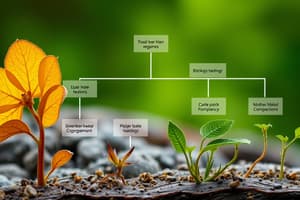Podcast
Questions and Answers
What are the basic characteristics common to all living organisms?
What are the basic characteristics common to all living organisms?
The basic characteristics include the ability to grow, reproduce, respond to stimuli, maintain homeostasis, and undergo metabolism.
Which of the following is the smallest structural and functional unit of an organism?
Which of the following is the smallest structural and functional unit of an organism?
- Organ
- Tissue
- Molecule
- Cell (correct)
An ____ is composed of several tissue types.
An ____ is composed of several tissue types.
organ
What is metabolism?
What is metabolism?
Homeostasis refers to a variable and changing internal environment.
Homeostasis refers to a variable and changing internal environment.
What genetic information is contained in DNA?
What genetic information is contained in DNA?
Which of the following processes is a mechanism of evolution?
Which of the following processes is a mechanism of evolution?
Flashcards are hidden until you start studying
Study Notes
Learning Outcomes
- Comprehend characteristics shared by all living organisms.
- Describe the organization levels in biological systems.
- Understand how living organisms are classified.
- Identify the steps of the scientific method.
Levels of Biological Organization
- Atoms combine to form molecules.
- Cells are the smallest units of life; can be single-celled or multicellular.
- Tissues are groups of similar cells performing a specific function.
- Organs comprise various tissue types working together.
- Organ systems consist of groups of organs with a shared purpose.
- Organisms are collections of organ systems functioning as a whole.
- Species represent groups of interbreeding organisms.
- Populations refer to members of a species in a defined area.
- Communities are interacting populations in an ecosystem.
- Ecosystems integrate communities with their physical environments.
- Biosphere encompasses all global ecosystems.
Energy and Metabolism
- Energy is required for work and is obtained through food.
- Food provides nutrients for energy and growth, maintaining vital body functions.
- Metabolism includes all chemical reactions in cells.
- The sun is the ultimate energy source for life on Earth.
- Photosynthesis converts solar energy into chemical energy, producing sugars for the food chain.
Homeostasis
- Homeostasis is the maintenance of a stable internal environment.
- Organ systems work to achieve homeostasis via responses to both external and internal stimuli (e.g., moving away from heat sources or adjusting blood pressure).
Reproduction and Development
- Organisms reproduce to pass on genetic information to offspring.
- Growth denotes increases in size and cell number.
- Development includes all changes from fertilization to death, encompassing growth stages and injury repair.
- DNA carries genetic information and directs cell function, containing genes that specify traits.
- Mutations introduce variations that can aid adaptation and evolution.
Evolutionary History
- Evolution refers to population changes over time, driven by natural selection.
- New variations that enhance resource acquisition result in more offspring.
- Over time, advantageous variations become more common in populations, leading to adaptation.
Classification of Life
- All life is categorized within three domains, including Bacteria and others.
Studying That Suits You
Use AI to generate personalized quizzes and flashcards to suit your learning preferences.




